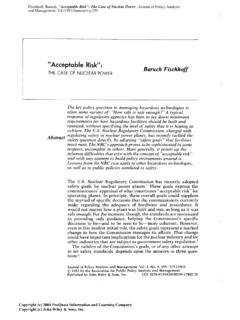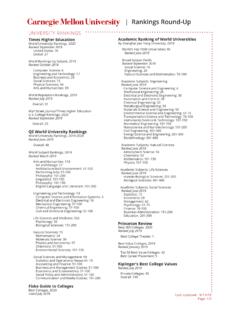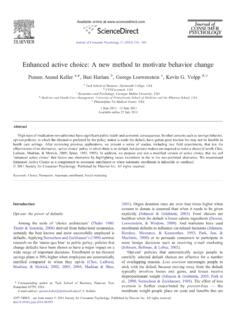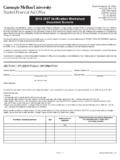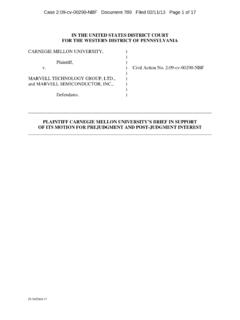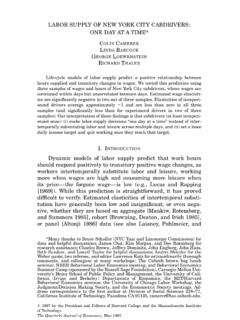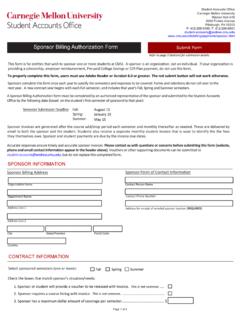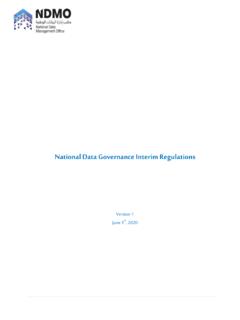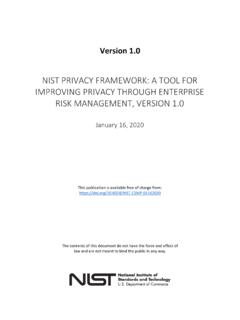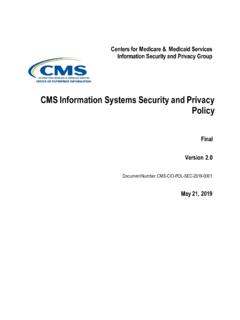Transcription of Computer Security Incident Response Plan
1 Computer Security Incident Response plan Name of Approver: Mary Ann Blair Effective Date: 23-FEB-2014. Date of Approval: 23-FEB-2014. Date of Review: 31-MAY-2016 Name of Reviewer: John Lerchey Table of Contents Table of Contents .. 2. Introduction .. 3. Purpose .. 3. Scope .. 3. Maintenance .. 3. Authority .. 3. Relationship to other 3. Relationship to Other Groups at CMU .. 3. 3. 3. Incident .. 3. Personally Identifiable Information (PII).. 4. Protected Health Information (PHI) .. 4. Roles and Responsibilities .. 5. Incident Response Coordinator .. 5. Incident Response Handlers .. 5. Insider 5. Law Enforcement .. 6. Office of General Counsel (OGC) .. 6. Officers .. 6. Users .. 6. Methodology .. 6. Constituencies.
2 6. Evidence Preservation .. 6. Operational-Level Agreements, governance .. 7. Staffing for an Incident Response Capability, 7. Training .. 7. Incident Response Phases .. 7. Preparation .. 8. 8. Containment .. 9. Investigation .. 9. Remediation .. 9. Recovery .. 9. Guidelines for the Incident Response Process .. 9. Insider 9. Interactions with Law Enforcement .. 10. Communications plan .. 10. Privacy .. 10. Documentation, Tracking and Reporting .. 10. Escalation .. 11. Further Information .. 11. Revision History .. 11. Computer Security Incident Response plan Page 2 of 11. Introduction Purpose This document describes the overall plan for responding to information Security incidents at Carnegie Mellon University.
3 It defines the roles and responsibilities of participants, characterization of incidents, relationships to other policies and procedures, and reporting requirements. The goal of the Computer Security Incident Response plan is to detect and react to Computer Security incidents, determine their scope and risk, respond appropriately to the Incident , communicate the results and risk to all stakeholders, and reduce the likelihood of the Incident from reoccurring. Scope This plan applies to the Information Systems, Institutional data , and networks of Carnegie Mellon University and any person or device who gains access to these systems or data . Maintenance The University's Information Security Office (ISO) is responsible for the maintenance and revision of this document.
4 Authority The ISO is charged with executing this plan by virtue of its original charter and various policies such as the Computing policy , Information Security policy , and HIPAA policy . Relationship to other Policies This plan incorporates the risk profiles for Institutional data as outlined in the Guidelines for data Classification. Relationship to Other Groups at CMU. The ISO acts on behalf of the University community and will ask for cooperation and assistance from community members as required. The ISO also works closely with University administrative groups such as the Student Life Office, Human Resources, and the Office of General Counsel in investigations and e-discovery matters, and at their behest may assist Law Enforcement.
5 Definitions Event An event is an exception to the normal operation of IT infrastructure, systems, or services. Not all events become incidents. Incident An Incident is an event that, as assessed by ISO staff, violates the Computing policy ;. Information Security policy ; other University policy , standard, or code of conduct; or Computer Security Incident Response plan Page 3 of 11. threatens the confidentiality, integrity, or availability of Information Systems or Institutional data . Incidents may be established by review of a variety of sources including, but not limited to ISO monitoring systems, reports from CMU staff or outside organizations and service degradations or outages. Discovered incidents will be declared and documented in ISO's Incident documentation system.
6 Complete IT service outages may also be caused by Security -related incidents, but service outage procedures will be detailed in Business Continuity and/or Disaster Recovery procedures. Incidents will be categorized according to potential for restricted data exposure or criticality of resource using a High-Medium-Low designation. The initial severity rating may be adjusted during plan execution. Detected vulnerabilities will not be classified as incidents. The ISO employs tools to scan the CMU environment and depending on severity of found vulnerabilities may warn affected users, disconnect affected machines, or apply other mitigations. In the absence of indications of sensitive data exposure, vulnerabilities will be communicated and the ISO.
7 Will pursue available technology remedies to reduce that risk. Personally Identifiable Information (PII). For the purpose of meeting Security breach notification requirements, PII is defined as a person's first name or first initial and last name in combination with one or more of the following data elements: Social Security number State-issued driver's license number State-issued identification card number Financial account number in combination with a Security code, access code or password that would permit access to the account Medical and/or health insurance information Protected Health Information (PHI). PHI is defined as "individually identifiable health information" transmitted by electronic media, maintained in electronic media or transmitted or maintained in any other form or medium by a Covered Component, as defined in Carnegie Mellon's HIPAA policy .
8 PHI is considered individually identifiable if it contains one or more of the following identifiers: Name Address (all geographic subdivisions smaller than state including street address, city, county, precinct or zip code). All elements of dates (except year) related to an individual including birth date, admissions date, discharge date, date of death and exact age if over 89). Computer Security Incident Response plan Page 4 of 11. Telephone numbers Fax numbers Electronic mail addresses Social Security numbers Medical record numbers Health plan beneficiary numbers Account numbers Certificate/license numbers Vehicle identifiers and serial numbers, including license plate number Device identifiers and serial numbers Universal Resource Locators (URLs).
9 Internet protocol (IP) addresses Biometric identifiers, including finger and voice prints Full face photographic images and any comparable images Any other unique identifying number, characteristic or code that could identify an individual Per Carnegie Mellon's HIPAA policy , PHI does not include education records or treatment records covered by the Family Educational Rights and Privacy Act or employment records held by the University in its role as an employer. Roles and Responsibilities The Incident Response Process incorporates the Information Security Roles and Responsibilities definitions and extends or adds the following Roles. Incident Response Coordinator The Incident Response Coordinator is the ISO employee who is responsible for assembling all the data pertinent to an Incident , communicating with appropriate parties, ensuring that the information is complete, and reporting on Incident status both during and after the investigation.
10 Incident Response Handlers Incident Response Handlers are employees of the ISO, other CMU staff, or outside contractors who gather, preserve and analyze evidence so that an Incident can be brought to a conclusion. Insider Threats Insiders are, according to CERT1, current or former employees, contractors, or business partners who have access to an organization's restricted data and may use their access to threaten the confidentiality, integrity or availability of an organization's information or 1. This is a paraphrase of the definition presented in the Software Engineering Institute's 2009 publication entitled Common Sense Guide to Prevention and Detection of Insider Threats (Capelli et al, third edition, ).
